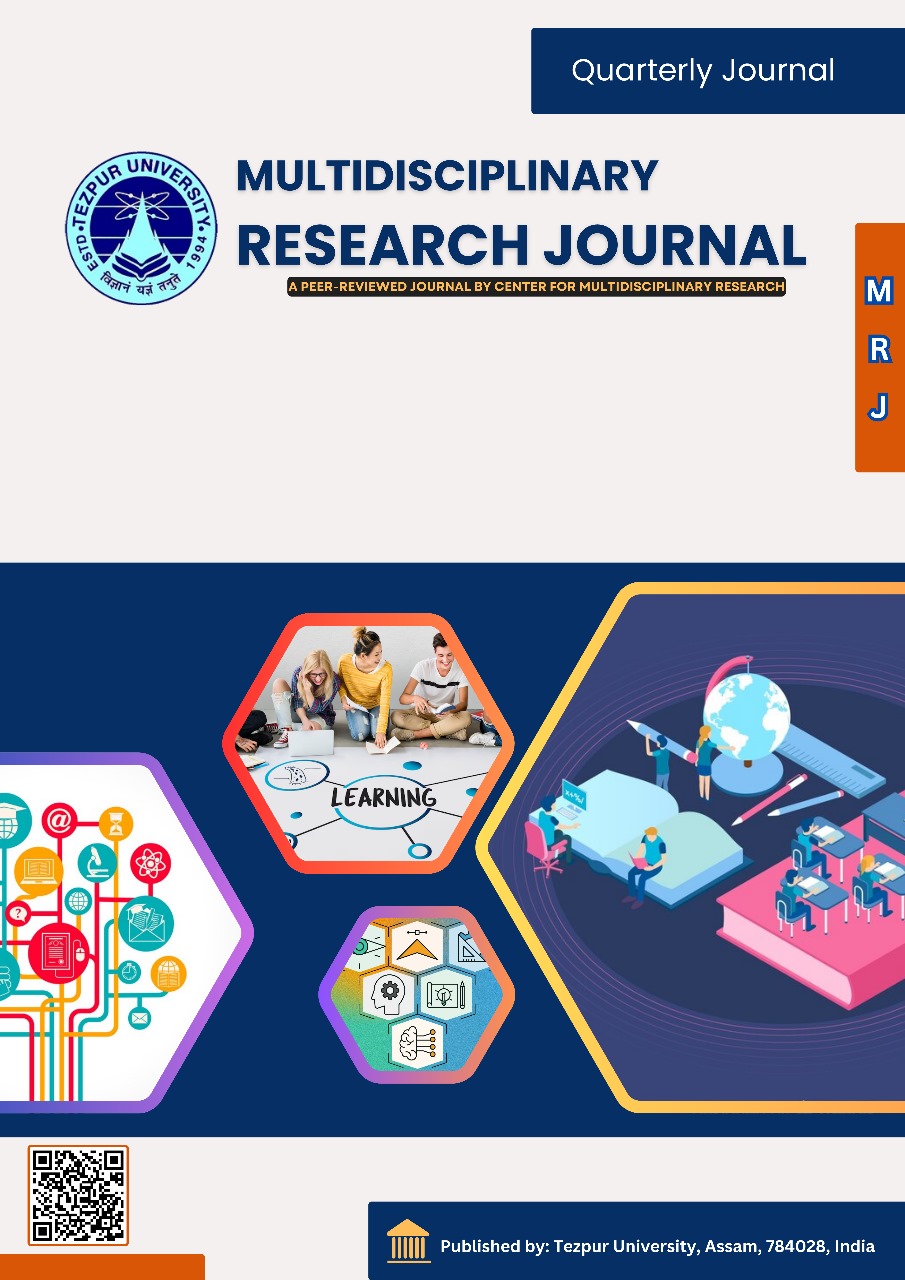A Longitudinal Single Case Study on Short-Duration Mind-Body Relaxation and Rejuvenation Technique Inspired from Ancient Mālā Japa
DOI:
https://doi.org/10.63635/mrj.v1i1.14Keywords:
Relaxation, Mind-body, Mala Japa, Rejuvenation, EEGAbstract
In this case study, we describe the experience of a short-duration meditation method called mind-body relaxation and rejuvenation technique (MBRRT), inspired by the ancient mālā japa. A middle-aged person practiced it for a period of two and a half years. During the MBRRT performance, the experience in terms of sleep was collected through a self-report proforma for 60 practice sessions. It was observed that the participant could sleep well in 32 sessions (more than 50%), could sleep only for some time in 19 sessions (more than 30%), could feel the sensation of sleep in 4 sessions, and only in 5 sessions, the participant did not experience sleep. In addition, the participant expressed calmness, relaxation, and rejuvenation after the MBRRT in all the sessions. A single-trial electroencephalogram (EEG) study was also performed on the participant during meditative and non-meditative resting states. It was observed that the low-frequency brain waves such as delta, theta, and alpha increased during the MBRRT performance whereas the high-frequency brainwaves, beta, and gamma got lowered in all the brain regions such as frontal, central, parietal, occipital, and temporal. The EEG result supported the sleep and relaxation experienced by the participant due to MBRRT. We believe the easy-to-perform method may be adapted for brief sleep or naps and fast relief from a stressful and exhausted mind.
Downloads
References
[1] Tripathi R (editor). Ṣāktānanda Ṭarangini, 1st ed.; Sampūrṇānanda Saṃskṛta Viśvavidyālaya – Varanasi, India, 1987; śloka 8/1,73
[2] Ṣrīmadbhagvadgītā - (10/25, 6/34)
[3] Available online: https://www.holy-bhagavad-gita.org/chapter/10/verse/25 (accessed on October 14, 2024)
[4] Svāmī Satyānaṃda Sarasvatī. Meditation from the Tantras, 2nd ed.;Yoga Publications Trust, Munger, India, 1983; pp. 153
[5] Gurvendra A. Mantra Mahāvijñāna, 1st ed.; Kitāba Mahala - New Delhi, India, 2020; pp. 202
[6] Jayswal A, Devi K, Deka A, et al. An easy and time-effective mind-body technique for relaxation and rejuvenation of the body and mind. Science and Culture (In Press)
[7] Jacobs GD. The Physiology of Mind–Body Interactions: The Stress Response and the Relaxation Response. The Journal of Alternative and Complementary Medicine 2001, 7(supplement 1), 83–92, doi:10.1089/107555301753393841
[8] Tseng AA. Scientific Evidence of Health Benefits by Practicing Mantra Meditation: Narrative Review. Int J Yoga 2022, 15(2), 89-95, doi: 10.4103/ijoy.ijoy_53_22
[9] Mohanty SN, Satpathy S, Chopra R, Mahato S. Investigating the impact of Mahā Mantra chanting on anxiety and depression: An EEG Rhythm Analysis Approach. Advances in Integrative Medicine 2024, 11(2), 74–83, https://doi.org/10.1016/j.aimed.2024.04.003
[10] Lee EJ, Bhattacharya J, Sohn C, Verres R. Monochord sounds and progressive muscle relaxation reduce anxiety and improve relaxation during chemotherapy: a pilot EEG study. Complement Ther Med 2012, 20, 409–416, DOI: 10.1016/j.ctim.2012.07.002
[11] Kobayashi S, Koitabashi K. Effects of progressive muscle relaxation on cerebral activity: An fMRI investigation. Complement Ther Med 2016, 26, 33–39. https://doi.org/10.1016/j.ctim.2016.02.010
[12] Xue, S., Tang, Y., Tang, R., & Posner, M. I. Short-term meditation induces changes in brain resting EEG theta networks. Brain and Cognition 2014, 87, 1–6. https://doi.org/10.1016/j.bandc.2014.02.008
[13] Steghaus S, Poth CH. Assessing momentary relaxation using the Relaxation State Questionnaire (RSQ). Scientific Reports 2022, 12(1), 16341, https://doi.org/10.1038/s41598-022-20524-w
[14] Luberto CM, Hall DL, Park ER, Haramati A, Cotton S. A perspective on the Similarities and Differences Between Mindfulness and Relaxation. Global Advances in Health and Medicine 2020, 9, 1–13, doi:10.1177/2164956120905597
[15] Gupta N, Arora J, Dixit R, Garg S, Agarwal JL. EEG patterns in long-term Brahmakumari meditators and their possible significance. Natl J Physiol Pharm Pharmacol 2024, 14(05):890-893, doi: 10.5455/njppp.2023.13.08422202315102023
[16] Jirakittayakorn N, Wongsawat Y. Brain responses to 40-Hz binaural beat and effects on emotion and memory. International Journal of Psychophysiology 2017, 120, 96–107 https://doi.org/10.1016/j.ijpsycho.2017.07.010
[17] Abhang PA, Gawali BW, Mehrotra SC. Technical Aspects of Brain Rhythms and Speech Parameters. In: self (ed) Introduction to EEG- and Speech-Based Emotion Recognition; Academic Press, United States, 2016, pp 51–79, https://doi.org/10.1016/C2015-0-01959-1
[18] West MA. Meditation and the EEG. Psychological Medicine 1980, 10(2), 369–375, https://doi.org/10.1017/s0033291700044147
[19] Jayswal A. Physiological effects of Meditation (Dhyāna): A short review of study results from the past 5 years. J Res Ayurvedic Sci 2024, 8, 113-8, doi: 10.4103/jras.jras_249_23
[20] Lee DJ, Kulubya E, Goldin P, Goodarzi A, Girgis F. Review of the Neural Oscillations Underlying Meditation. Frontiers in Neuroscience 2018, 12, 178, https://doi.org/10.3389/fnins.2018.00178
[21] Gupta Atridev (Translator). Aṣṭāṃga Saṃgraha, Nirnay Sāgar Publication, Mumbai, India, 1951; śloka (1/9/39)
[22] Colgan DD, Memmott T, Klee D, Ernst L, Han SJ, Oken B. A single case design to examine short-term intracranial EEG patterns during focused meditation. Neuroscience Letters 2019, 711, 134441, https://doi.org/10.1016/j.neulet.2019.134441
[23] Rawal P, Vyas M, Baghel AS, Kamble S. Efficacy of Sattvavajaya Chikitsa in the form of relaxation techniques and Guda Pippalimula Churna in the management of Anidra (insomnia) – An open labelled, randomized comparative clinical trial. Ayu 2019, 40, 89-96, doi: 10.4103/ayu.AYU_91_17
Downloads
 Abstract Display: 452
Abstract Display: 452  PDF Downloads: 180
PDF Downloads: 180 Published
Issue
Section
License

This work is licensed under a Creative Commons Attribution-NonCommercial 4.0 International License.
Copyright © Author(s) retain the copyright of this article.




